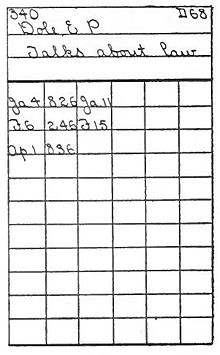A Library Primer (1899)/Chapter XXXII

On the inside of the front cover of every book in the library paste a manilla pocket. (See Library Bureau catalog.) Or paste, by the bottom and the upper corners, thus making a pocket of it, a sheet of plain, stout paper at the bottom of the first page of the first flyleaf. On this pocket, at the top, write the call-number of the book. Below this print information for borrowers, if this seems necessary. In this pocket place a book-card of heavy ledger paper or light cardboard. On this book-card, at the top, write the call-number of the book in the pocket of which it is placed.
To every borrower the library issues a borrower's card. This card is made of heavy, colored tag-board, and contains the borrowers' name and address, and his number in the series of borrowers' numbers.
The librarian, before delivering a book to a borrower, takes from the pocket the book-card, writes on it the number found at the top of the borrower's card, and after it, with a dater, stamps the day of the month. At the same time he stamps the same date on the borrower's card, and on the pocket in the book or on a dating slip pasted in the book opposite the pocket.

The borrower's card he places in the book pocket, the book-card he retains as a record of the loan, and the borrower takes the book away. The book-card, with all others representing the books issued on the same day, he places in a tray behind a card bearing the date of the day of issue. All the book-cards representing books issued on a certain day are arranged in the order of their call-numbers.

Under this system the borrower can tell, by looking at his card, on what date the book he has was taken from the library. If he wishes to renew it without taking it back to the library, he can do so by a letter stating that he took on a certain day a book bearing a certain number, and wishes it renewed.
The librarian can tell, from the book-cards, what books are in circulation, and how many of each class were lent on a certain day.

No. 1. Postal notice. (Reduced.)
The borrower's number, written on the book-card of any given book in circulation, will give, through the register of borrowers, the name and address of the person having that book. Overdue books are automatically indicated, their cards remaining in the tray, behind the card indicating the date they were lent, after the day for their return has passed.
When a borrower returns a book the librarian can learn, from the date on the pocket, whether or no a fine should be paid on it; if not, he can, if in haste, immediately take out the borrower's card from the book pocket, stamp the date of its return at the right of the date on which it was lent, thus canceling the charge against the borrower, and lay the book aside and look up its book-card later.

No. 2. Registration card, face. (Reduced; actual size, 7½ x 12½ cm.)

No. 3. Registration card, reverse. (Reduced; actual size, 7½ x 12½ cm.)
Double and special borrowers' cards are not needed under this system. It accommodates itself readily to a "two-book" system. On the book-cards belonging to the second book, and all other books after the first, which any borrower may take, the librarian writes the borrower's number preceded by any letter or sign which will serve to indicate that these books are charged, not on the borrower's card, but to the borrower direct, on the strength of a general permission to him to take more than one book.

No. 4. Overdue notice. (Postal card, reduced.)
The postal notice no. 1, the registration cards 2 and 3, the notice that the book is overdue, no. 4, the fine slip, no. 5, all explain themselves.
In most places, certainly in all small towns, a sufficient safeguard against the loss of books is found in the signature of the borrower himself. No guarantee need be called for. To ask for a guarantor for a reputable resident is simply to discommode two people instead of one. The application which the borrower signs should be brief and plain. Name, residence, place of business, and any necessary references, should be written in by the librarian on one side; the signature to an agreement to obey the library rules can be written by the applicant on the other. All borrowers agreements should be filed in alphabetical order. They should receive borrowers' numbers in the order of their issue, and the date. The borrowers' cards should state that they expire in a definite number of years from the date of issue, and the date of issue should be stamped on them. An index of borrower's agreements should be kept by their numbers. This need contain only the borrower's number, his name, and, when necessary, his address. It is conveniently kept in a book. It is better to keep it on cards.

No. 5. Fine slip. (Reduced; actual size 12½ x 7½ cm.)
